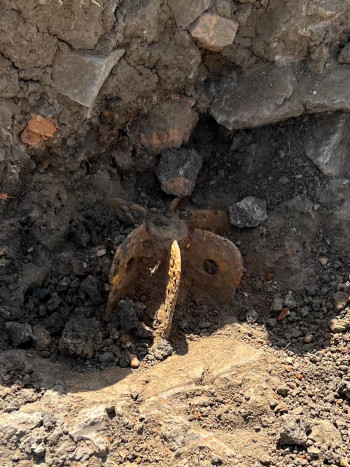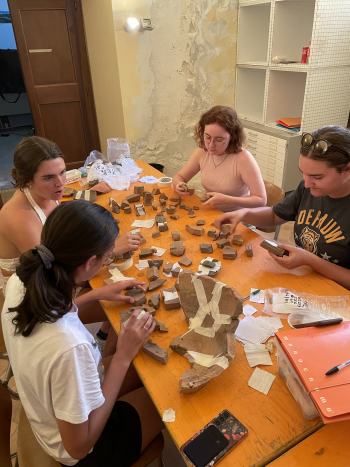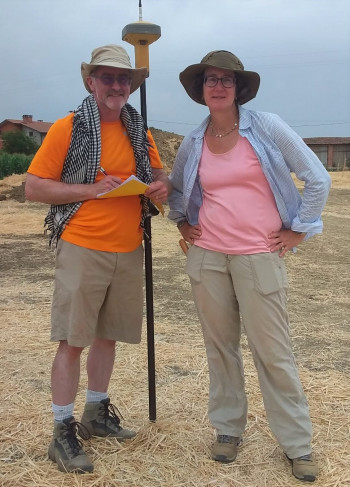Rebecca Schindler and Pedar Foss have spent much of their careers digging up ancient artifacts, but the one they and their DePauw University students uncovered July 4 came as something of a surprise.
As the leaders since 2015 of several archaeological digs in central Italy, Schindler and Foss have overseen a number of students conducting field work, during which they’ve found many antiquities that date as far back as the second century BCE and are housed at a museum in Castiglione del Lago. Such field work is a rarity for undergraduates, said Schindler, the Edwin L. Minar professor of classical studies. Foss is professor and chair of classical studies as well as Schindler’s spouse.
The recent artifact is historic, though of considerably more recent vintage: An unexploded mortar shell, circa 1944, the remnant of a battle between Allied forces and Germans.
 “A clump of earth sort of popped off, as it often does, and then what you can see in the ground is just a tail fin,” Schindler said in a recent Zoom call from Italy. “The rest of the rocket casing is imbedded in the ground. …
“A clump of earth sort of popped off, as it often does, and then what you can see in the ground is just a tail fin,” Schindler said in a recent Zoom call from Italy. “The rest of the rocket casing is imbedded in the ground. …
“It was one of those things where it’s not unexpected, just given the history of the region, but it was really unanticipated because we would have thought that, in the intervening years, with all the agricultural work that had happened in the region since World War II, leftover munitions from the war would have already been uncovered.” (Photo: only the tail fin of the mortar shell was visible.)
The discovery set Foss off on a research project in which he learned that the shell was launched June 24, 1944, by British troops as they battled – ultimately successfully – to break through German defenses on a line from Vaiano to San Fatucchio.
 The downside of this unusual discovery is that the dig had to be suspended. The local police cordoned off the shell and told Schindler the dig could proceed, but the local government authority who supervises the activity nixed that until the military can remove the shell. To occupy the students, who were four weeks into a six-week expedition, Schindler and Foss had them inventory items that had been found thus far; observe creation of three-dimensional models facilitated by Mike Boyles of DePauw’s Tenzer Technology Center; learn about geographic information systems; and visit a nearby museum. (Photo: Students inventory archaeological artifacts.)
The downside of this unusual discovery is that the dig had to be suspended. The local police cordoned off the shell and told Schindler the dig could proceed, but the local government authority who supervises the activity nixed that until the military can remove the shell. To occupy the students, who were four weeks into a six-week expedition, Schindler and Foss had them inventory items that had been found thus far; observe creation of three-dimensional models facilitated by Mike Boyles of DePauw’s Tenzer Technology Center; learn about geographic information systems; and visit a nearby museum. (Photo: Students inventory archaeological artifacts.)
The expedition, which is set to end Saturday, involved the largest group Schindler and Foss have ever overseen – 10 DePauw students and 12 students from other U.S. schools who signed up via the Umbra Institute, DePauw’s partner. Students were involved for the first time since 2019; no expeditions were undertaken in 2020 or 2021, thanks to COVID-19, though Schindler and Foss spent three weeks last year doing research with their Italian colleagues.
During that time, they learned about a promising archaeological site in a farm field near Ranciano. Local residents have long known about the site; tile and pottery pieces are visible on the field’s surface and, when an irrigation channel was cut years ago, a bronze figurine of Eros with a sword was discovered. A magnetometry survey also suggested the site might prove fruitful.
Indeed, the team discovered a kiln, several broken but otherwise complete cooking pots, numerous shards of pottery, many fragments of bronze and iron and what Schindler called “the most remarkable find”: a small carnelian gem depicting a shepherd dressed in a cloak and heavy cap and holding a staff. A goat stands in front of him. The team also found more coins “than we were able to excavate in five seasons at the other site,” Schindler said.
 The other site is a Roman villa that dates from the second century BCE to the late third century AD and that likely was a luxury estate that over time was converted into a large agricultural complex. The team is likely to return to that site someday but, meanwhile, expansion to the Ranciano site supported the team’s vision of this as “a regional project to understand not just one site in the territory but to understand the whole history of the territory.” (Photo: Foss and Schindler.)
The other site is a Roman villa that dates from the second century BCE to the late third century AD and that likely was a luxury estate that over time was converted into a large agricultural complex. The team is likely to return to that site someday but, meanwhile, expansion to the Ranciano site supported the team’s vision of this as “a regional project to understand not just one site in the territory but to understand the whole history of the territory.” (Photo: Foss and Schindler.)
It is unclear if the new site also was a villa or a cluster of small houses, but “it seems to be an important site,” she said, and the team will apply to continue its work there next summer.
(Top photo: Students conduct an archaeological dig at a farm field near Ranciano, Italy. All photos provided by Rebecca Schindler.)
Browse other stories
-
Athletics
-
Football - Robby Ballentine Repeats as D3football.com Second Team All-America
-
Men's Basketball - DePauw Extends Win Streak to Five; Jacobs Reaches 1,000-Point Plateau
-
Women's Basketball - Tigers Top Ephs for Third Straight Win
More Athletics
-
-
News
-
Student and Professor Share Unexpected Writing Journey
-
Four in a Row! DePauw Wins 131st Monon Bell Classic
-
Jim Rechtin '93 Featured in Fortune Magazine
More News
-
-
People & Profiles
-
Entrepreneurs Eric Fruth ’02 and Matt DeLeon ’02 Are Running More Than a Business
-
Rick Provine Leaves Legacy of Leadership and Creativity
-
History Graduate Cecilia Slane Featured in AHA's Perspectives on History
More People & Profiles
-
-
Have a story idea?
Whether we are writing about the intellectual challenge of our classrooms, a campus life that builds leadership, incredible faculty achievements or the seemingly endless stories of alumni success, we think DePauw has some fun stories to tell.
-
Communications & Marketing
101 E. Seminary St.
Greencastle, IN, 46135-0037
communicate@depauw.eduNews and Media
-
News media: For help with a story, contact:
Bob Weaver, Senior Director of Communications.
bobweaver@depauw.edu.